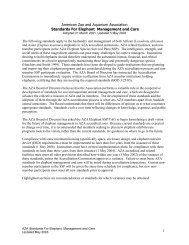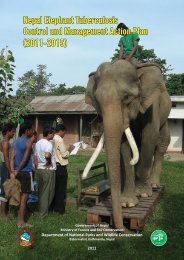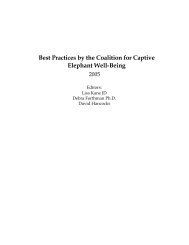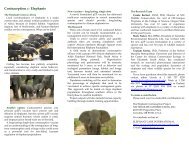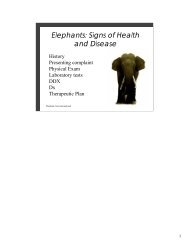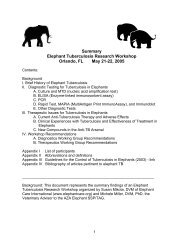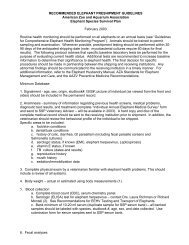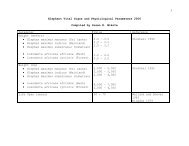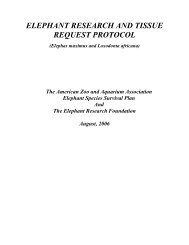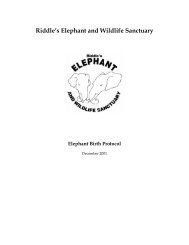Elephants Elephants - Wildpro - Twycross Zoo
Elephants Elephants - Wildpro - Twycross Zoo
Elephants Elephants - Wildpro - Twycross Zoo
- No tags were found...
You also want an ePaper? Increase the reach of your titles
YUMPU automatically turns print PDFs into web optimized ePapers that Google loves.
3.4.2 Captive Elephant Diet SurveyINTRODUCTIONFor the 2001 survey, information was requested by questionnaire on thequantity and types of food and water offered, and on the weight and life stageof the elephants. The questionnaire (Appendix 6, Section 6.6.1) requestedinformation on a single day’s food ration for each elephant. Nutrient contentlabels from commercial feeds used and the results of any feed analyses werealso requested to be able to enter all the feed components into the <strong>Zoo</strong>tritionprogramme. If foods were fed without nutritional information beingprovided, <strong>Zoo</strong>trition’s own database or published information for those foodswere used, in order to give an approximation of the diet. No hay or forageused by UK zoos had been subject to proximate analysis to determine drymatter, fibre, protein etc., thus ‘book’ values for UK hay (MAFF 1986) wereused instead. It has to be emphasised that all nutrient summaries presentedin this survey are estimations based on published data, not exactmeasurements.All eighteen collections housing elephants in Britain and Ireland wereapproached for this study. Of them, fifteen collections responded and elevenprovided sufficient information to allow an analysis to be carried out using<strong>Zoo</strong>trition version 1.0 software. Responses were provided for a total of 55(13.42) elephants. One of these animals was pregnant at the time of the study,and four were lactating. These animals have been excluded from the analysis,as their metabolic requirements would be different to adult maintenancerequirements. Young animals under 10 years of age have also been excludedfor the same reason. The analysis was performed on a sample size of 34 (6.28);detailed results are given in Appendix 6, Section 6.6.2).Diets for Asian and African elephants have not been differentiated, since, afterpreliminary examination, neither total protein content of the diets norbodyweight of Asian and African elephants in the collections significantlydiffer (t-test, df32, p>0.05). One collection houses both species and feeds thesame diet to both.The results of the study are summarised in Table V. All nutrientconcentrations in this section are reported on a dry matter (DM) basis.FEEDING TRENDSAll diets were based on hay, and in most cases were supplemented withequine concentrates, vitamins and other produce such as bread, fruit andvegetables. To understand the variation between the diets, groups ofnutrients will be considered separately. <strong>Elephants</strong> were fed an average ofthree times a day; however the feeding policy of the collections variedbetween 1-7 feeds per day. One collection provided elephants with acontinuous supply of feed throughout the day. Daily dry matter intakesranged from 0.7%-2.9% bodyweight. This compares to 1.0-1.9% ofbodyweight measured in wild African and Asian elephants.48




